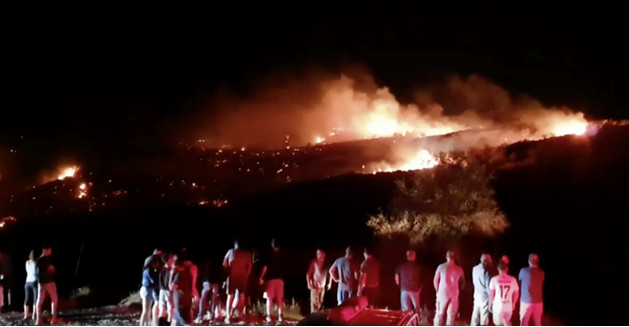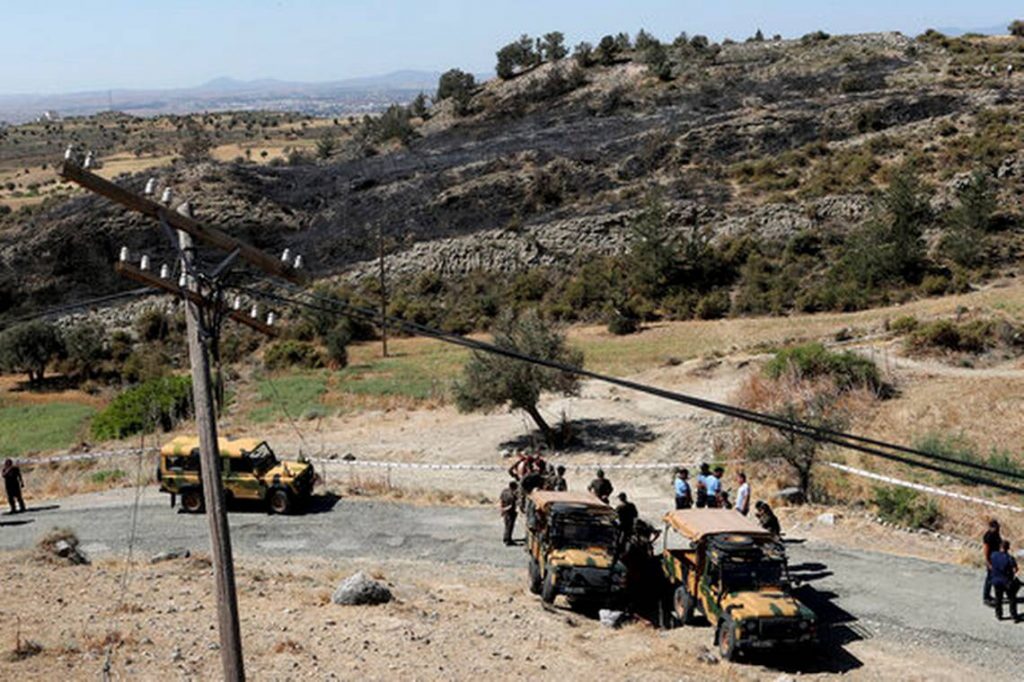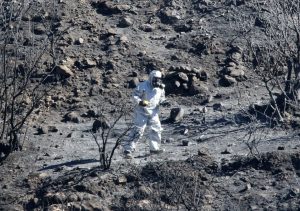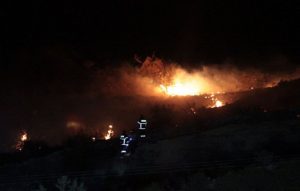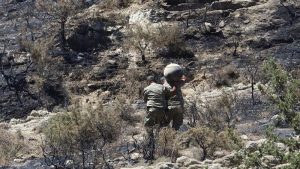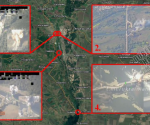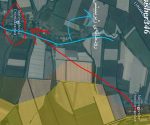The case of the errant missile that set fire to an entire hillside in Cyprus
As far as the consensus goes, overnight into the first day of July, the Israelis launched an attack with standoff air-to-ground missiles into areas in the west of Syria – that is to say, rather, there were reports of injury, killing and destruction by explosion of ordnance, for which the Syrians blamed Israel; plus the Syrians operated their air defences against airborne targets – with, by some accounts, the reasonably good results that we have grown accustomed to expect. Indeed, in spite of what appears copiously on the internet about the ability of Israel to project power into Syria, the author still has not seen any evidence to change his opinion that the Israelis are seriously constrained by the Syrian Air Defence Force (SyADF): he still suspects that in order to maintain an illusion of superiority in the domain, Israel must by necessity stage something more hybrid than straightforwardly putting planes in the air; i.e. launch missiles from vessels at sea, or use special operations overland (see the “further reading” listed at the foot of the page).
On the other hand, there is distinct evidence that demonstrates the real potency of SyADF capability – even from July 1st, although by no means has it been immediately apparent. Being referred to is the story out of Cyprus that told of a Syrian S-200 surface-to-air missile that had gone astray and had self-destructed over the island, scattering debris over quite a sizeable area in the Turkish occupied part, but mostly in a nature reserve in a place called Vouno (or Taskent). It is the images out of this place that beg anyone with a working set of eyes to discern a reality different than that of an official narrative – that being said, the internet as best it can be searched is largely quiet.
In what constitutes a clue in its own right, the undisputed “facts” of a Syrian missile, crash-landed in Cyprus, were echoed unanimously by British, American and Israeli corporate-media on Monday and Tuesday this week, and it was only RT, picking up on something said by the Turkish-Cypriot foreign minister, that wondered if the downed object was in fact something else:
Kudret Ozersay… was more specific with his guesses. “Initial findings indicate the object that caused the explosion was either an aircraft carrying explosives or a direct explosive [missile],” he wrote on Twitter.
Following up, RT included in its piece an image showing some of the wreckage, annotated and (originally) posted (elsewhere) to the internet to claim that the object in question was in fact an F-16 war plane. This claim was extremely hopeful, given that the image appeared to show – even to a layman – the tail fins of a missile. Indeed, we can’t discount the possibility that someone had rustled up what was essentially a lot of nonsense to eliminate the idea of a plane crash in the deliberations of the sort of audience that wouldn’t automatically accept the official account.
The very little by way of query in the alternative media is inversely proportional to the surprising amount of treatment from the corporate-media, where the overwhelming sense in the reporting was of a missile that had gone rogue: was “stray”, or “errant” – any descriptor that would convey an impression that the missile had not been hunting Israeli aircraft when it crashed. Indeed, Turkish and Turkish-Cypriot media voices actively gave the impression that potential victims of the Syrian missile would have been nowhere in the vicinity, one way or another because of the clever wiles of the Israelis:
Arda Mevlutoglu, a defense policy expert, who said the missile could have been fired by Syrian air defense against Israeli fighter jets. But Mevlutoglu added it was not clear whether a plane was an actual target. He wondered whether Syrian air defense systems might have been tricked by means of electronic warfare to think there had been an Israeli target in the area.
Another political analyst, Serdar Sement who was quoted on Turkish websites, claimed that Israel has the capability to know electronically the direction of a missile and thus fighter jets can avoid it.
Trying to understand why the Turks would be interested in promulgating the myth of Israeli invincibility is not within the scope of this article – all we are here to do is to notice the uniform treatment in what we might call NATO-country media, and the universal instruction to its audience to not even begin to contemplate the notion of Israeli planes being involved in the incident. We will make one observation, however, which is that the myth of US invincibility is also at stake if US-made Israeli war planes are shot down by a raggedy bunch of Syrians.
There is a problem, of course, for an explanation for the incident in Cyprus that doesn’t involve Israeli war planes, because if that were truly the case, then this explanation must account for why the missile was stray, why it was stray over Cyprus, and why it would explode in order to be scattered across the territory in which it was found. As it happens, the Turkish-Cypriot authorities did offer a partial explanation, and prior to dealing with that, we must first examine some material that emerged after an incident of 17th March, 2017, when a number of Syrian S-200s flew into Israeli airspace. The Israelis claimed that one of these missiles was shot down by their own air defences, and that two others landed harmlessly in Israel after their targets had evaded them. Quite equally, for all we know, the Syrians may well have shot down one F-16 and destroyed another – as they claim. Indeed, the only solid evidence for examination from our armchair may not support the Israeli version, because it consists of photographic documentation of a missile – said to be an Israeli Arrow (anti-missile missile) – which landed in an incredibly well preserved state in Jordan, suggesting that it had not actually hit anything.
So, the reason why this older incident is so important is that it appears to be when the rationale for a stray S-200 was first established. The Drive website, which is emergently indispensible when it comes to such matters, reported the following:
It is possible that some of the SA-5s [the NATO reporting name for S-200s], or whatever missiles were launched by Syrian forces, were fired in “ballistic” mode as a defensive measure. During a ballistic launch, SAMs are fired unguided toward a suspected threat to put that threat on the defensive, or as an act of desperation because the target can’t be successfully acquired by the system’s fire control radar. The missiles either self destruct once reaching a high altitude or continue on their ballistic trajectory once their rocket motors burn out.
In accordance with the supposed behaviour of the S-200 as set out above, the partial explanation for the missile in Cyprus involves it self-destructing. As an extract from the southern Cyprus Mail indicates, it was an idea that was initially promulgated by the Turks:
The S-200 missile that crashed into an area in the north in the early hours of Monday had likely self-destructed in the air, a geopolitical analyst has told the Cyprus Mail.
“Surface-to-air missiles like the S-200 have a self-destruct setting when they miss their target,” said Zenonas Tziarras of the Geopolitical Cyprus think-tank.
That would be consistent with reports from the north from people saying they heard an explosion before the remains of the object crashed onto the ground. There was also no impact crater, Turkish Cypriot authorities said, lending weight to the hypothesis the missile had exploded before hitting the ground.
That we have two sets of “expertise” telling us the same sort of thing doesn’t make any of it true (which, in turn, doesn’t necessarily make liars out of the “expertise” – so often “expertise” merely means subscription to the most popular, or financially rewarding opinion). Indeed, when one investigates the S-200 for oneself, it appears to be the case that there are two ways that it can detonate. The first is automatically when it acquires close proximity to its target. The second is when a signal is sent to it from its operator to destruct. The idea that the S-200 has an automatic ability to kill itself may well be a convenient fallacy. If it destructed over Cyprus, it was because it was ordered to – and herein lies a mystery.
In the following extract from the Cyprus Mail, the reader is asked to notice, once again, the insistence – this time by Cypriot government sources – that Israeli planes (visible on radar, with the implication being that this information must be relied on) were not in the Nicosian flight information region which extends pretty much all the way to the Levant coast bar 10 or 20 km out to sea:
Government sources said the island’s flight information region had not been used by Israel during the attacks. Israeli aircraft taking part were tracked by radar, which however cannot trace an object with the size and speed of the missile. It is estimated that the missile reached Cyprus in under two minutes from the time it was launched.
The idea that an audience is perhaps supposed to form from this is that the Syrian missile missed its target close to Syrian borders or even in Syrian airspace. But if that were so, why would Syrian air defence wait until the missile had traversed 200 km of Mediterranean sea before issuing the command to destruct? Moreover, if the missile was launched on a ballistic trajectory (presumably meaning straight up and down) to constitute a warning shot, why was it sent to Cyprus?
The only possibility that makes sense is that the missile was targeting an object that had arrived close in proximity to Cyprus at the end of the two minutes that it took to converge at the point also. Indeed, the author would like to suggest that a plane was shot down – and believes there is evidence to support the hypothesis. For the first example of such a thing, please see the following extract, also from the Cyprus Mail piece linked to above, and please notice the extent of the depositing of the wreckage:
The object is believed to be a stray Russian-made S-200 missile launched by the Syrian air defence against a massive Israeli airstrike overnight.
Five parts have so far been found in three villages north of Nicosia after a deafening crash in the early hours on Monday morning…
The five parts of the missile have so far been found in the villages of Vouno, Dikomo and Kornokypos. One part was found in a yard of a house in Dikomo, where three homes were evacuated.
Two parts were found in Kornokypos and two belonging to the main part of the missile were found in Vouno…
According to the author’s rough approximation, Dikomo (Dikmen) and Vouno (Taskent) are about 5 km apart – but this does not have to be extraordinary; insubstantial fragments from one object may well descend in such a fashion. However, logic suggests that a greater volume of material will disperse over a greater area (or, have a better chance to more widely disseminate). According to the author’s reckoning, there is only about 10m³ worth of material in an S-200. Is it too insubstantial for the spread that it had to cover – especially when one considers the terrible mess it made at Vouno?
Vouno was where the tail piece of a missile was found – a tail piece that was intact to the extent that it still resembled itself – which would be logical, and perhaps typical, given that the tail is the furthest part of the missile away from a warhead that is designed to fragment its target essentially with shrapnel. So, the question that needs asking is, if the warhead had been obliterated, and also with it – we can assume – the most part of the body of the missile except the tail piece, what was it in Dikomo that warranted an evacuation?
We should also note that there wasn’t a “deafening crash” so much as a series of explosions. Doug Sivri, a Briton staying in Kyrenia (Girne) on the coast, and about 10 miles from Vouno, told The Sun that:
I could hear a rumbling at first and then after that two or three explosions… It sounded like fireworks because it was quite loud. I wasn’t sure what it was really but when I saw the news it was quite scary.
That there were in fact three explosions is something that has been verified in other accounts – and this is surely not how a single missile disposing of itself would behave. Re-examine, dear reader, the initial assessment by Kudret Ozersay whereby the cause of the explosion could have been “an aircraft carrying explosives or a direct explosive [missile]”. How about both: first the detonation of the warhead on the missile, and then perhaps the ordnance being carried by the target craft – by which is meant airplane, because another missile would presumably also just blow up once.
Now, consider the extent of the debris field at Vouno. The first image below shows the scene at the time soon after the crash landing. As the reader can see for himself, there are numerous patches where a fire is burning – and please notice the multitudinous minor spots of combustion. Remember that the S-200 had probably travelled two-thirds of its range when it reached Cyprus (assuming that it was launched on the Syrian coast). Of course, for all we know, the arid land at the site may well have burst into flames strictly from the energy imparted by the object that had struck it, but if the conflagration shown was fuel-fed, one must ask if the S-200 had enough on board sufficient to the task.
The second image further down the page shows the same site in daylight. The landscape is clearly recognisable from the night-time picture because of the ridges. This image tells us that the fires were spread across an area stretching from the side of the highest peak on the right, down to the opposite slope of the large hillock behind the telegraph pole on the left. This must be about two or two and half football fields in length; while the width of the area might be harder to gauge, it is nevertheless astonishing too. If it is reasonable to call this the debris field of a crashed S-200 missile, then in comparison the one that landed in Gazientep in July, 2018 must have been placed where it was photographed.
What is being referred to is a precedent that we can use as contrast. Indeed, from the Mirror, we know that the Turkish-Cypriot foreign minister Kudret Ozersay, did make his own comparisons:
Mr Ozersay said markings on debris matched those found on a Russian-made S-200 missile that hit Gazientep, Turkey in July last year.
The S-200 that came down in Gazientep Province pretty much merely consisted of its own tail piece – at least, as far as one can tell from the image below (on the left – and from here).
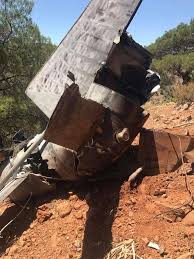 |
 |
The image on the right, however, is the tail section at Vouno – but please notice the extensive burning in the background and how the Gazientep example appears not to have ignited its environs to spoil the healthy red earth on which it is perched.
Now, dear reader, consider the two images below that show just how extensively the site at Vouno was in fact devastated by fire. The one with the “Turkish military official” in a hazmat suit (from the Cyprus Mail) is particularly illustrative.†
Is this really the work of one rogue S-200 missile?
Or is it the work of something else? We do know that ahead of the incident on Monday morning, the Israelis themselves had concluded that it was very likely that the Syrians had made their four S-300 batteries operational. Moreover, it has now been suggested elsewhere on the internet that the Israelis were somehow acting in retaliation for the development.
The question of whether or not the Israelis would have been capable of targeting the Syrian upgrade is not something that the author has anything near the technical knowledge, nor the research time, to answer. Similarly, there is no way to understand if the Syrians had decided to put their new equipment through its paces – although the Russians have commented to say that the S-300s had not been used [link needed].
From a British perspective, though, the most intriguing area of speculation must stem from the location of the crash site – there is, of course, an RAF base on Cyprus. Moreover, the RAF recently deployed F-35s to the base, after which followed some manoeuvres with others using the same equipment: “British, American, and Israeli pilots carried out an F-35 exercise, which comes at a time of unprecedented British-Israeli military cooperation”.
One can’t help but wonder if yesterday’s seizure by the British of an “oil tanker bound for Syria” is somehow related to, or perhaps a consequence of the case of the errant missile that set fire to an entire hillside in Cyprus.
Further reading:
Analysis: the Israeli airstrike that never was? Iran to be provoked by smoke and mirrors? (link)
Under pretence of dealing with Iran, Israel goes after air defences; Russia should rethink the S-300 to Syria (link)
† The image in question poses more questions than answers. In the same vein, another image taken at Vouno (below) suggests that the Turks might have been moving pieces of debris off the site as soon as they were cool enough to touch. Indeed, there were people on the crash scene while the debris was yet ablaze (again, see image below). We could be generous and say that Turkish investigators work incredibly swiftly – in the dark to boot. Or we can be cynical and wonder if there was a great rush to have any debris that wouldn’t fit the narrative swept away ahead of the cold light of day. Perhaps a knowledgeable reader would like to get in touch to let us know where this canister-like object is supposed to be located on an S-200.




